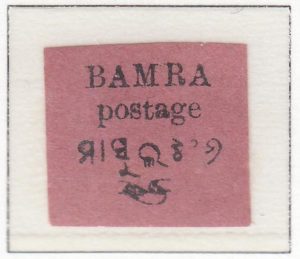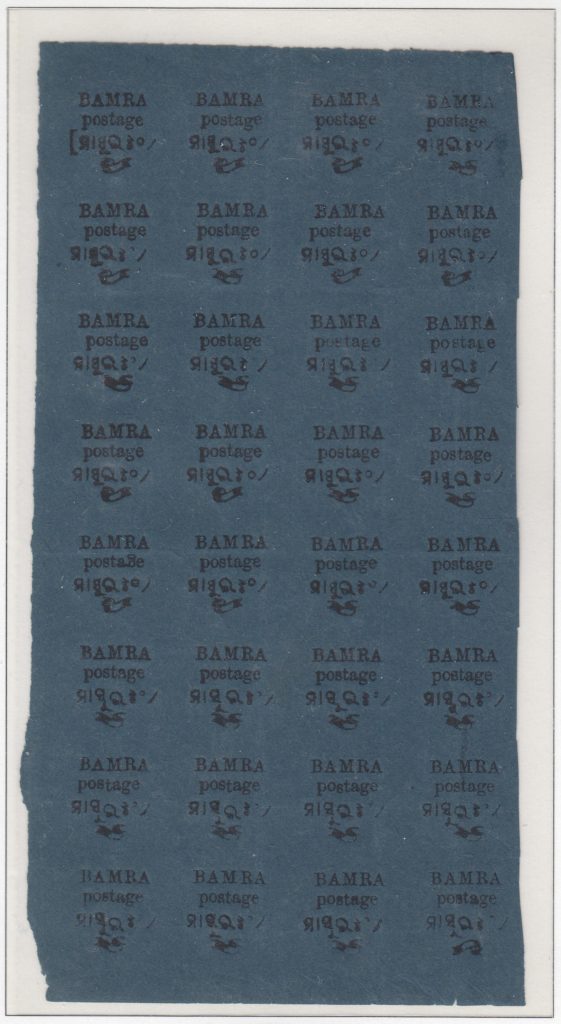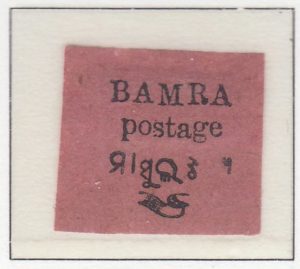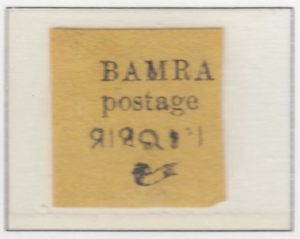
Population 123,378 (1901)
Bamra (or Bamanda) was a princely state in the Eastern States, Orissa States Agency, Bengal (present-day Odisha State). Raja Sudhal Deo ruled over the state from 1869-1903, issuing the first stamps in 1888.
The stamps were typeset from the same plate of 96 stamps (12 rows of 8), but for the one quarter a, 1a, and 2a, only part of the plate was used. They were issued imperforate, without gum, and became obsolete at the end of 1904.
Click here to see all stamps from Bamra in this exhibition.
History
Bamra was a state that had and maintained strong tribal traditions. The Bhuiya, a tribe whose name means “lord of the soil,” has a powerful presence, as did the Khond, with hunter-gatherer traditions.
According to legend, in the 1500s, a child from the Gangabasi Rajput dynasty of Patna, was stolen by the Bhuiya and Khond, and placed on the throne of Bamra. Although rulers can be listed from 1673, the small state of Bamra was often forced to pay tribute, or accept the direct rule, of larger powers. From 1775, it was under the power of the Maratha empire. When the Marathas were defeated by the British, Bamra came under British control, signing its first treaty with the British East India Company treaty in 1821. From that time forward, Bamra paid tribute to British interests.
As the Tribal Chief Tribhuvan Singh had no direct heirs, he received the necessary sanad of adoption for Raja Sudhal Deo, his nephew, in 1869. This prince reigned until 1903. A monarch, a poet, writer, and translator, Sudhal did much to further education and literature. He increased the number of primary schools from 1 to 28, encouraged the study of Sanskrit and the native Oriya tongue, and abolished child marriage. He improved the taxation system, built transportation, and established a police system, post office, and paper currency. Relations with Britain continued, as, for example, lands were given to Britain for the construction of the Bengal Nagpur railway in 1899. Sudhal’s son and successor helped develop electricity, postal service, and accessibility to clean water.
As a small state, Britain serially assigned Bamra to different administrative units; at independence it was part of the Orissa state. British sovereignty ended, of course, in 1947, but all did not go smoothly thereafter. The ruler of Bamra, according to reports, incited the tribes to agitate and not join the Orissa states, who wanted to be consolidated with them. With his aims unsuccessful, Bamra eventually became part of larger India on January 1, 1948. Today, a Rajah reigns in name, but has no administrative responsibilities.
Bamra
1888





The paper used for printing of Bamra stamps were very thin. Now the paper condition is deteorating and has become brittle in nature. Protection in BOPP jackets are also not sufficient. Small card board behind the stamps are providing some protection. Now these stamps are not available in Bamra state (Present name is Deogarh) declared as a district after being carved out from Sambalpur district since 1994 under the State Government of Odisha. My home town Sambalpur is 90 kilometres away from Deogarh.